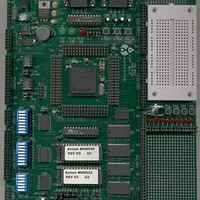MPC555CME Freescale Semiconductor, MPC555CME Datasheet - Page 620

MPC555CME
Manufacturer Part Number
MPC555CME
Description
KIT EVALUATION FOR MPC555
Manufacturer
Freescale Semiconductor
Type
Microcontrollerr
Datasheet
1.MPC555CME.pdf
(966 pages)
Specifications of MPC555CME
Contents
Module Board, Installation Guide, Power Supply, Cable, Software and more
Processor To Be Evaluated
MPC555
Data Bus Width
32 bit
Interface Type
RS-232
For Use With/related Products
MPC555
Lead Free Status / RoHS Status
Contains lead / RoHS non-compliant
- Current page: 620 of 966
- Download datasheet (13Mb)
17.2 TPU3 Components
17.2.1 Time Bases
17.2.2 Timer Channels
17.2.3 Scheduler
17.2.4 Microengine
MPC555
USER’S MANUAL
The microcode ROM TPU3 functions that are available in the MPC555 / MPC556 are
described in
The TPU3 consists of two 16-bit time bases, 16 independent timer channels, a task
scheduler, a microengine, and a host interface. In addition, a dual-ported parameter
RAM is used to pass parameters between the module and the CPU.
Two 16-bit counters provide reference time bases for all output compare and input
capture events. Prescalers for both time bases are controlled by the CPU via bit fields
in the TPU3 module configuration register (TPUMCR) and TPU module configuration
register two (TPUMCR2). Timer count registers TCR1 and TCR2 provide access to the
current counter values. TCR1 and TCR2 can be read by TPU microcode but are not
directly available to the CPU. The TCR1 clock is always derived from the IMB clock.
The TCR2 clock can be derived from the IMB clock or from an external input via
theT2CLK clock pin. The duration between active edges on the T2CLK clock pin must
be at least nine IMB clocks.
The TPU3 has 16 independent channels, each connected to an MCU pin. The chan-
nels have identical hardware and are functionally equivalent in operation. Each chan-
nel consists of an event register and pin control logic. The event register contains a
16-bit capture register, a 16-bit compare/match register, and a 16-bit greater-than-or-
equal-to comparator. The direction of each pin, either output or input, is determined by
the TPU microengine. Each channel can either use the same time base for match and
capture, or can use one time base for match and the other for capture.
When a service request is received, the scheduler determines which TPU3 channel is
serviced by the microengine. A channel can request service for one of four reasons:
for host service, for a link to another channel, for a match event, or for a capture event.
The host system assigns each active channel one of three priorities: high, middle, or
low. When multiple service requests are received simultaneously, a priority-scheduling
mechanism grants service based on channel number and assigned priority.
The microengine is composed of a control store and an execution unit. Control-store
ROM holds the microcode for each factory-masked time function. When assigned to a
channel by the scheduler, the execution unit executes microcode for a function as-
signed to that channel by the CPU. Microcode can also be executed from the dual-port
RAM (DPTRAM) module instead of the control store. The DPTRAM allows emulation
and development of custom TPU microcode without the generation of a microcode
ROM mask. Refer to
/
MPC556
APPENDIX D TPU ROM
17.3.6 Emulation Support
TIME PROCESSOR UNIT 3
Rev. 15 October 2000
FUNCTIONS.
for more information.
MOTOROLA
17-2
Related parts for MPC555CME
Image
Part Number
Description
Manufacturer
Datasheet
Request
R

Part Number:
Description:
MPC555 Interrupts
Manufacturer:
Freescale Semiconductor / Motorola
Datasheet:
Part Number:
Description:
Manufacturer:
Freescale Semiconductor, Inc
Datasheet:
Part Number:
Description:
Manufacturer:
Freescale Semiconductor, Inc
Datasheet:
Part Number:
Description:
Manufacturer:
Freescale Semiconductor, Inc
Datasheet:
Part Number:
Description:
Manufacturer:
Freescale Semiconductor, Inc
Datasheet:
Part Number:
Description:
Manufacturer:
Freescale Semiconductor, Inc
Datasheet:
Part Number:
Description:
Manufacturer:
Freescale Semiconductor, Inc
Datasheet:
Part Number:
Description:
Manufacturer:
Freescale Semiconductor, Inc
Datasheet:
Part Number:
Description:
Manufacturer:
Freescale Semiconductor, Inc
Datasheet:
Part Number:
Description:
Manufacturer:
Freescale Semiconductor, Inc
Datasheet:
Part Number:
Description:
Manufacturer:
Freescale Semiconductor, Inc
Datasheet:
Part Number:
Description:
Manufacturer:
Freescale Semiconductor, Inc
Datasheet:
Part Number:
Description:
Manufacturer:
Freescale Semiconductor, Inc
Datasheet:
Part Number:
Description:
Manufacturer:
Freescale Semiconductor, Inc
Datasheet:
Part Number:
Description:
Manufacturer:
Freescale Semiconductor, Inc
Datasheet:










